Septic tank made of concrete rings: device, schemes + step-by-step installation process
A solid septic tank made of concrete rings allows you to organize wastewater treatment up to 70%, but the percentage of treatment in it is lower than in high-tech biological stations (98%). Although such a system is several times cheaper, and its device is simpler. Why not use it to equip the sewage system in the country, right?
Do you want to build a septic tank on your own and do not know where to start? We will help to thoroughly understand all the subtleties of this issue. The article discusses in detail the structure of a concrete storage device, detailed schemes of its construction. As well as a step-by-step installation process, starting with the preparation of materials and ending with the launch of the system into operation.
The article is supplemented by visual photos and videos in which the nuances of the functioning of the septic tank and the process of constructing a two-chamber treatment plant are analyzed.
The content of the article:
How to place a septic tank on a site?
Concrete rings are a good material for the manufacture of sewers in private households. If the territory does not belong to nature protection zones, then you can save on sewage, since the cost of such a septic tank is half the price of buying a treatment plant.
Before starting work, it is necessary to determine the type of soil on the site. The choice of a filtration system depends on its characteristics, since the design of a septic tank made of concrete rings involves several containers. According to sanitary standards, water should be subjected to three-day or more sedimentation before it is discharged into the ground.
The type of soil can be determined by digging a pit, interviewing neighbors who own a well or well, requesting information from the organization conducting the construction or drilling near the site.
Slightly higher loam filtration coefficient, slightly higher for sandy loam. However, their filtration properties are still not enough for the device on the above clay soils soil treatment systems.
In addition, almost all clay soils are characterized by heaving - the ability to increase in size during freezing and decrease during thawing. These soil shifts can easily push concrete tanks out, completely destroy them or simply squeeze them until cracks appear.
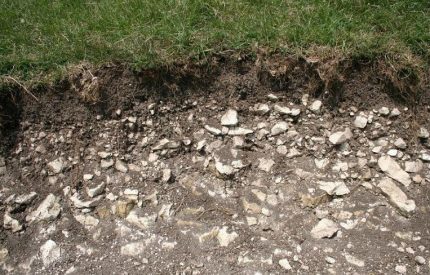
Sand, gravel, pebble and gravel sedimentary rocks have good absorbing properties. They freely pass water into their thickness, do not impede its movement into the underlying layers.
True, coarse deposits, such as gravel and gravel, occur mainly in the floodplains of the rivers, and gravel is at the foot of rock formations.
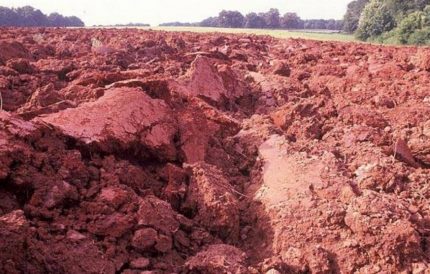
On river and mountain slopes, filtering facilities are not suitable, because part of the drainage fluid will not be able to go through a post-treatment cycle sufficient for disposal into the soil.
Therefore, normal conditions for arranging filtration fields, absorption wells and installing infiltrators are considered to be sandy soils of all degrees of coarseness and density, except for dusty ones.
In addition to geological conditions, it is necessary to observe the norms of its location from residential buildings and water sources.

If sanitary standards are neglected, biological water pollution can occur. Dangerous pathogens of infectious diseases develop in sewer drains. These include E. coli, which causes severe poisoning.It easily reaches the source of drinking water through groundwater.
The nuances of calculating the required capacity
To organize a septic tank from concrete rings it is necessary to calculate the volume based on daily water consumption. According to the norms, 200 cubic liters of water per day is necessary for one permanently resident person.
The first tank for sedimentation should have a volume of three times the size of consumption (200 l) per person. The second tank with a bottom for settling should have a volume equal to 1/3 of the size of the first.
The rules for the construction of a two-chamber treatment plant can be found in our other article.
The number of rings can be determined by dividing the volume of the tank by the volume of the ring. Their size is small, medium and large.
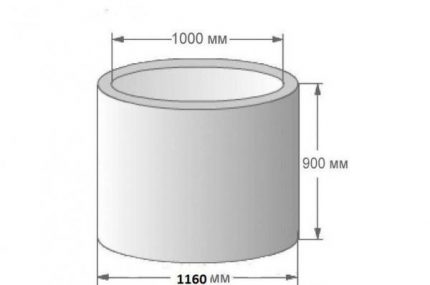
For a family of two:
The volume of the first tank = (200 * 2) * 3 = 1,200 liters.
Volume of the second and third capacity = 1,200 / 3 = 400 liters.
The number of rings for two containers = (1200 + 400) / 700 = 4
The number of rings for three containers = (1200 + 400 + 400) / 700 = 5
Result: 2 rings for a settling tank, 2 for a sedimentation tank and one for a drainage well.
For a family of three:
The volume of the first tank = (200 * 3) * 3 = 1,800 liters.
Volume of the second and third capacity = 1,800 / 3 = 600 liters.
The number of rings for two containers = (1 800 + 600) / 700 = 4
The number of rings for three containers = (1 800 + 1200) / 700 = 6
Result: 2 rings for a sump, 2 for a sedimentation tank and two for a drainage well.
Schemes of septic systems
Schemes of septic tanks made of concrete rings suggest the presence of one, two or three chambers, where the sediment is sedimented and their biological processing takes place.

In fact, a single-chamber septic tank is a conventional storage device, the drains from which are pumped out by sewers.
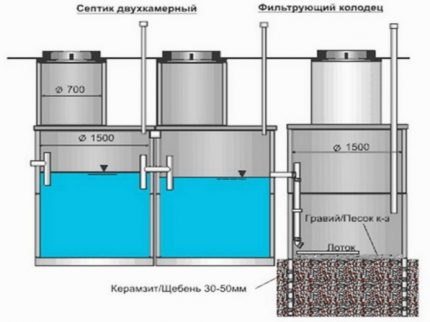
The first and second containers must have a bottom. This is followed by the third compartment, where soil cleaning is also carried out. The next stage of purification is the removal of sediment in the cells and clarified wastewater into the soil through the bottom filter well.
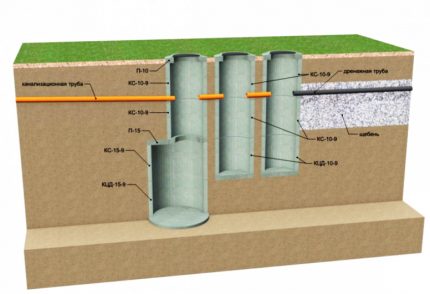
All cameras are arranged with a monolithic bottom, cleaning is done by settling. The settled liquid is discharged into the infiltrator or filtration field for subsequent disposal into the soil.
Depending on the absorption capacity of the soil, you can choose several filtration options for the septic tank from concrete rings:
- Septic system with filter field.
- Septic system with an absorbing well.
- Septic system with filter cartridge (infiltrator).
The most common filtration option is a drainage well. It is used with good absorption properties of the soil.
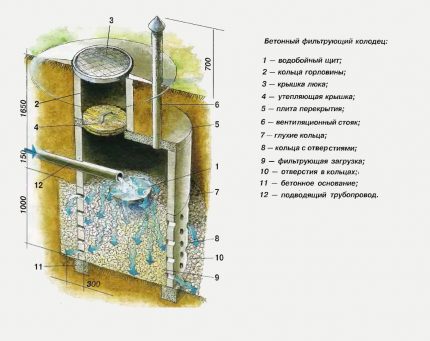
Between the level of the conditional bottom of the absorption well and the highest level of ground water in the autumn / spring rainy season there is no meter required by the standards, a filtration field is set. For its construction on the site should be enough space.
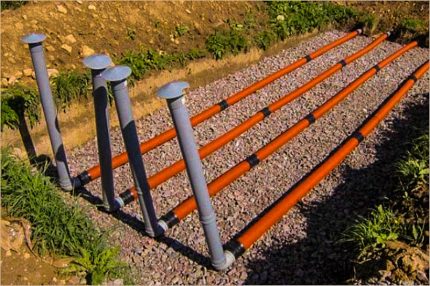
This is the best solution for sites where the groundwater level does not exceed 2.5 meters. It should be remembered that between the lower edge of the drain of the filtration field and the roof of the water-saturated formation, there should also be a thickness of soil with a thickness of at least a meter.
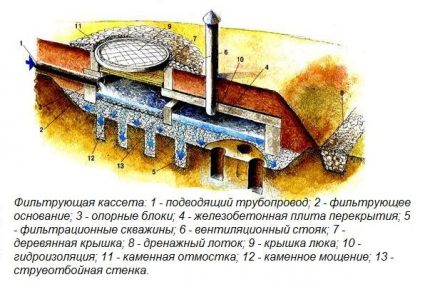
This design is not widespread in the CIS countries.
You need to decide on a filtration system before mounting a septic tank made of concrete rings, since this will allow you to prepare in advance the foundation pit of the required size and depth.
If filter systems are installed after installation is completed, pipes and tanks can be damaged. Therefore, the space that borders the wall of the second deposition tank will have to be dug manually without the use of special equipment.
Installation of a septic tank with two sedimentation tanks
Before starting work, it is necessary to check the groundwater level. This can be done if the house has a cellar or basement, without a concrete bottom. It is necessary to measure the height from the ceiling to the surface layer of soil. This is the depth to which you can dig.
To find out how deep the groundwater lies, you can dig a small in diameter but deep hole. Groundwater begins when a clearly damp earth appears. This is a sure sign, no further digging is necessary.
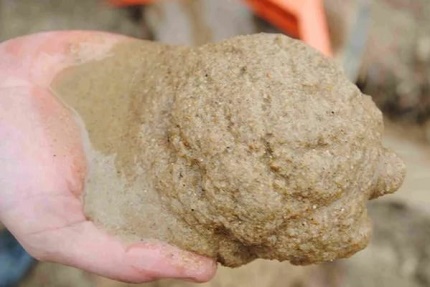
After the approximate level of water fishing has become known, you can begin excavation work. It is necessary to outline the place where the septic tank will be located. To do this, you need to outline the pits. To do this, you need to take a construction thread or any strong thread, measure 80 cm. Tie two pegs to both ends.
Stick one end in the middle of the place where you plan to place the first sedimentation tank. Draw a circle. This is the approximate diameter of the desired pit. Next, you need to step back a meter, and draw the boundaries for the second tank. Next, you need to outline the boundaries of the filtration structure.
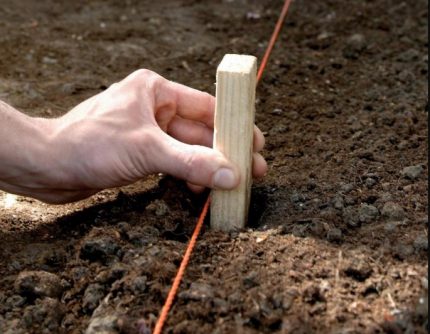
Step # 1 - selecting supplies and tools
Before you begin, you need to collect all the necessary materials and tools.
For work you will need:
- puncher and large drill bit for concrete;
- mixer tip to the punch;
- shovel and bayonet shovels;
- stairs;
- level:
- buckets;
- container for kneading the solution;
- strong nylon rope;
- hose;
Materials for mounting a septic tank made of concrete rings:
- cement;
- sand;
- gravel;
- bitumen or liquid glass;
- metal staples;
- mineral wool or expanded polystyrene;
After the equipment for all stages of work will be selected and prepared, you can start digging a hole.
Step # 2 - digging a foundation pit for a septic tank
If you think that it is difficult to excavate in such volumes manually, you can therefore use the services of organizations equipped with special equipment.
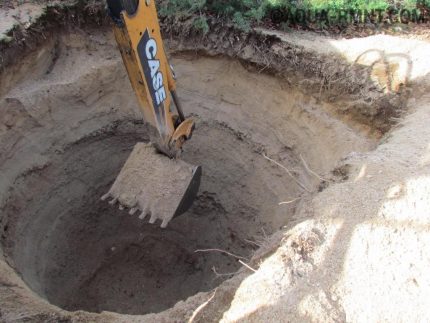
At the bottom of the pit, sand must be poured where the lower rings of the tanks will be installed. The thickness of the sand cushion is 20-25 cm. The base must be leveled. Next, sand must be shed with water so that shrinkage occurs. After pressing the sand base, you can break to the installation of rings.
Step # 3 - installation of sedimentation tanks
To install the concrete rings pre-delivered to the site for the septic tank, you need to build a base. To do this, a wooden formwork is arranged along the perimeter of the bottom of the pit. The height of the walls of the formwork should be at the level of 30-40 cm.
After the construction of the formwork, it is necessary to lay the reinforcing mesh and dilute the cement mortar. To do this, you need to take 1 part of cement to three parts of ASG (a mixture of sand and gravel).
You can mix the solution with a construction mixer. As a plasticizer, you can add two tablespoons of liquid soap to the solution. This will make the concrete more resistant to pressure and moisture.
After pouring the base, you need to wait 10 to 14 days until the solution hardens and gains the necessary strength. Formwork can not be removed. If rented equipment is used, it is advisable to purchase ready-made concrete slabs as a base.
After the base is ready, you can mount the rings. The weight of concrete structures is impressive, so you need to use a crane. Installation of containers is carried out in stages.
The first ring is immersed on the concrete base. Following it, the second falls and sets. The ring must be moved smoothly, avoiding bumps or slipping. After installation, bracing is done.

In the next step, until the cover is lowered, it is necessary to cover the seams between the rings.After installing the overlap in the tank, it will become dark and there is a risk of leaving unprocessed joints. For this, cement mortar is used.
You may also be interested in information on the waterproofing of a septic tank made of concrete rings, in detail parsed here.
For convenience of movement inside the tank running brackets are mounted. They are necessary for servicing the septic tank in case of blockages or depressurization.
The adjacent deposition tank is installed in the same manner. In both tanks, you need to make holes for sewer pipes and mount them. The inlet for sewage should be higher than the overflow pipe between the tanks.
Next, you need to install the overlap with holes sufficient so that a person can go down through them.
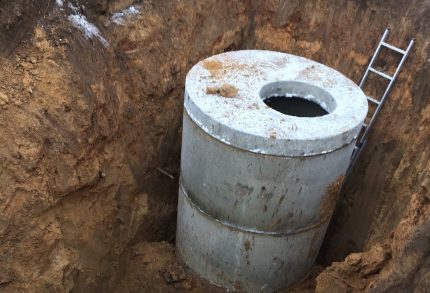
This completes the installation of a septic tank made of concrete rings, and the installation of a ventilation system follows.
Step # 4 - installing the ventilation system
Ventilation is necessary for air to enter the system, which ensures the normal functioning of microorganisms. They process domestic waste water and exempt from the organic component. To ensure a constant circulation of air flow, two ventilation pipes are required.
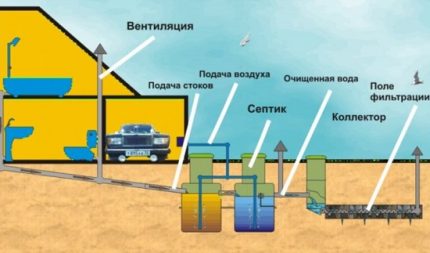
In this case, it is necessary to lay an electric cable to warm the pipe, since in the collision of warm and cold air, condensate forms in it, which blocks the access of oxygen.
It must be fixed with fasteners or clamps. The length of the vertical background riser should be at least the height of the wall of the house.
Ventilation also eliminates the unpleasant odor that periodically appears from containers and can spread throughout the house. Often this occurs with a prolonged absence of living and drying of the liquid in the siphon.
The second pipe is mounted in the overlap of the deposition tank. To do this, using a puncher in the ceiling, a hole is punched that matches the diameter of the ventilation pipe.
The duct should rise above the earth's surface by 70-100 cm. The position of this pipe will be fixed by the gravity of the soil and does not need additional fastening.
Another way to solve a bad odor problem is to install check valve for sewage, which is installed at the point of withdrawal of the sewer system from the house.
Step # 5 - installation of the filtration system
Next, we consider step-by-step instructions for arranging the aeration field and the filter well.
Option # 1 - arrangement of the filtering field
From the second concrete tank, the pipe exits into the distribution well. For the well, you can use a plastic barrel in which to cut holes suitable for aeration pipes.
You can purchase a ready-made distribution well.
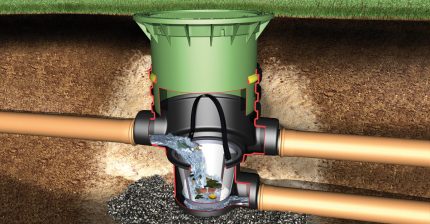
To do this, you need to purchase pipes based on the field size. For a family of four, an area of 20 square meters (10 × 2) is sufficient. For this, you will need three pipes 10 m long. In addition, you will need three corner pipes where the ventilation pipes will be mounted.
The field is pre-covered with sand and gravel in order to improve the absorption capacity of the soil.
Perforated pipes connected to the distribution well are laid on the prepared drainage.At the ends of the aeration pipes, corner pipes are mounted into which the background riser is installed, one for each pipe.
After this, the pipes are closed with geotextile and filled with a mixture of gravel with sand, then leveled. As siltation, the filtration field must be moved or cleaned, changing the drainage.
Option # 2 - installation of a filter well
The filter well has several advantages over the aeration field. It takes up less usable area on the site.
But the quality of the treated water will be higher at the aeration field, since before entering the groundwater, the effluents will be filtered by soil, and its layer under the aeration field is much larger than that of a well with drainage. The area of the well cannot cope with the amount of effluent that the aeration site receives.
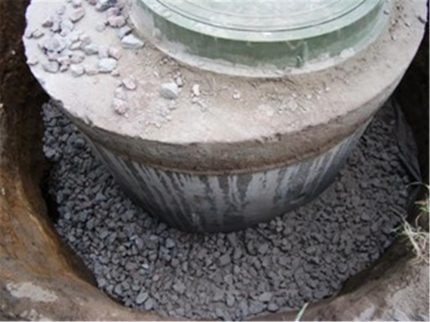
To install a well is based on the same principles as sedimentation tanks, excluding concreting of the bottom of the tank. In addition to the sand cushion, crushed stone, gravel, or other filtering composition should be placed at the bottom of the well. The standard capacity of the soil filter in the absorption well is calculated from 1 m or more.
To increase its throughput, it is possible to supplement the filtration well with lateral drainage. For its arrangement, the bottom concrete ring of the septic tank must be perforated.
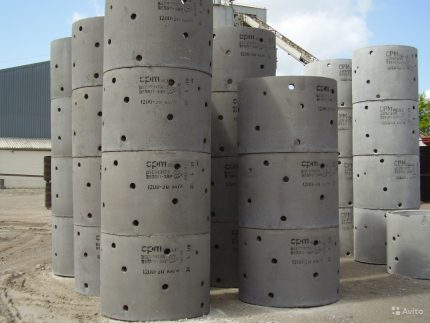
This process is best done on the surface until the ring is lowered into the pit. You also need to make a hole for overflowing water from the deposition tank, it should be located slightly lower than the previous overflow.
The walls and joints of the filtering well must be stapled, but there is no need to seal them. By connecting overflows, you can dig in the structure. The first ring must be sprinkled with rubble from the outside, to the junction with the second segment. The rest of the volume can be covered with soil from the infield.
Step # 6 - preparation for launch
If the temperature in winter drops below 30 degrees, it is necessary to prepare insulation for indoor manhole covers. Since the container itself is located below the freezing level, it does not need additional insulation.
To insulate the lid, you need to take polystyrene and cut a circle suitable for the diameter of the inner small concrete ring.

Next, you need to cut out the lid itself. For this, ordinary plywood of sufficient strength is suitable. You can screw the door handle to it in order to conveniently open it. Similarly, it is worth insulating the inner covers of the second deposition tank and drainage well.
Before using the septic tank, the first sedimentation tank must be filled with water 1⁄4 of its volume. Into a filled container add biological product, which will help the septic tank reach full capacity faster.
After these steps, you must close the hatches.
Conclusions and useful video on the topic
The video shows the installation process of a two-chamber septic tank in stages:
How the septic system functions:
If the construction of the septic system of concrete rings is carried out in compliance with the rules, it will last for 20 years.
We must not forget about the rules of operation and timely service. The pipes are made of plastic, so they are easy to damage.It is strictly forbidden to place equipment or a car in the place where the tanks are located.
Are you building a septic tank on your site? Do you have any questions during the process? Ask them in the comments to this article - we will try to help you in finding the right solution in this situation.

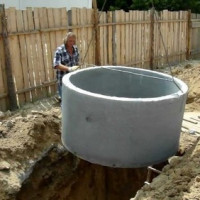 How to make a two-chamber septic tank from concrete rings: a building instruction
How to make a two-chamber septic tank from concrete rings: a building instruction 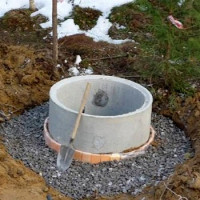 How to make a septic tank out of rings with your own hands: schemes and options + step-by-step instructions
How to make a septic tank out of rings with your own hands: schemes and options + step-by-step instructions 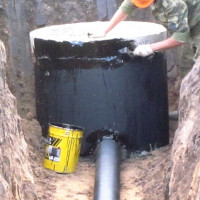 Waterproofing a septic tank made of concrete rings: a review of materials + rules for implementation
Waterproofing a septic tank made of concrete rings: a review of materials + rules for implementation 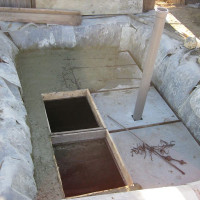 Do-it-yourself monolithic concrete septic tank: schemes and rules for arranging a concrete septic tank
Do-it-yourself monolithic concrete septic tank: schemes and rules for arranging a concrete septic tank 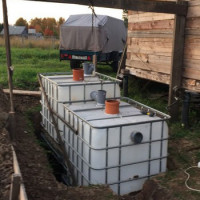 How to make a septic tank from European cubes with your own hands: step-by-step assembly instructions
How to make a septic tank from European cubes with your own hands: step-by-step assembly instructions  Septic “Uponor”: device, advantages and disadvantages, review of the model range
Septic “Uponor”: device, advantages and disadvantages, review of the model range  How much does it cost to connect gas to a private house: the price of organizing gas supply
How much does it cost to connect gas to a private house: the price of organizing gas supply  The best washing machines with dryer: model rating and customer tips
The best washing machines with dryer: model rating and customer tips  What is the color temperature of light and the nuances of choosing the temperature of the lamps to suit your needs
What is the color temperature of light and the nuances of choosing the temperature of the lamps to suit your needs  Replacement of a geyser in an apartment: replacement paperwork + basic norms and requirements
Replacement of a geyser in an apartment: replacement paperwork + basic norms and requirements
Unfortunately, no one makes a septic tank of concrete rings using such technologies described here. Usually they dig a hole, the bottom is not concreted, a concrete ring is put, the next one is laid and so on until the end. It is made for the natural outflow of liquid sewage and its absorption into the soil, as the siltation of the well is carried out, solid sediment is pumped out.
The service life is also not less than 20 years, but at the same time there is a sedimentation of the soil, washing away the foundation, pollution of the soil layers and water. When silting up such a sewage system, when even water cannot leave, the well will have to be moved, and the entire sewage system must be redone.
Thanks for the article, good stuff. My question is - is there a strong smell from the slop (first) tanks in the summer when the temperature is up to 40 *? And in the summer cottage, provided that the sumps will slowly fill up?